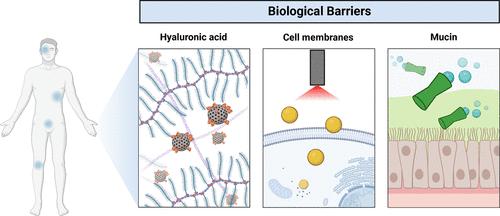微纳米马达:目标和高效生物医学的工程工具
IF 16
1区 材料科学
Q1 CHEMISTRY, MULTIDISCIPLINARY
引用次数: 0
摘要
在过去的二十年中,纳米技术在微电机(mm)和纳米电机(NMs)的开发和应用方面取得了重大进展。它们具有自我推进和在液体中游动的能力,已成为各个领域,特别是生物医学领域的有前途的工具。本文综述了mmms和NMs的现状,它们在粘性介质和复杂环境中的运动,它们与生物屏障的相互作用以及潜在的治疗应用。我们确定选择适当的给药途径以达到其目标位置是mm和NMs在生物医学应用中成功的关键方面。展望未来,我们设想NMs在治疗多种医学疾病中发挥关键作用,因为最近的体内概念验证研究证明了它们独特的能力和多功能性。然而,解决监管、可扩展性、生物相容性和安全性问题仍然是将NMs成功转化为临床试验和工业规模生产的必要条件。本工作为研究人员提供了指导,引导他们了解纳米材料和纳米材料在生物医学中的应用现状、挑战和前景,从而鼓励他们在纳米医学的未来中负责任的发展和定位。此外,我们概述了进一步研究的关键领域,包括生物相容性,安全性和克服物理障碍的方法的研究。本文章由计算机程序翻译,如有差异,请以英文原文为准。

Micro- and Nanomotors: Engineered Tools for Targeted and Efficient Biomedicine
Over the past two decades, nanotechnology has made significant progress toward the development and applications of micromotors (MMs) and nanomotors (NMs). Characterized by their capability to self-propel and swim in fluids, they have emerged as promising tools in various fields, particularly in biomedicine. This Review presents an overview of the current state of MMs and NMs, their motion in viscous media and complex environments, their interaction with biological barriers, and potential therapeutical applications. We identify the choice of appropriate administration routes to reach their target location as a key aspect of the success of MMs and NMs in biomedical applications. Looking ahead, we envision NMs playing a key role in treating diverse medical disorders, as recent proof-of-concept in vivo studies demonstrate their distinct capabilities and versatility. However, addressing regulatory, scalability, biocompatibility, and safety concerns remains imperative for the successful translation of NMs into clinical trials and industrial-scale production. This work provides a guideline for researchers, guiding them through the current landscape, challenges, and prospects of using MMs and NMs in biomedicine, thereby encouraging their responsible development and positioning in the future of nanomedicine. Furthermore, we outline critical areas for further research, including studies on biocompatibility, safety, and methods to overcome physical obstacles.
求助全文
通过发布文献求助,成功后即可免费获取论文全文。
去求助
来源期刊

ACS Nano
工程技术-材料科学:综合
CiteScore
26.00
自引率
4.10%
发文量
1627
审稿时长
1.7 months
期刊介绍:
ACS Nano, published monthly, serves as an international forum for comprehensive articles on nanoscience and nanotechnology research at the intersections of chemistry, biology, materials science, physics, and engineering. The journal fosters communication among scientists in these communities, facilitating collaboration, new research opportunities, and advancements through discoveries. ACS Nano covers synthesis, assembly, characterization, theory, and simulation of nanostructures, nanobiotechnology, nanofabrication, methods and tools for nanoscience and nanotechnology, and self- and directed-assembly. Alongside original research articles, it offers thorough reviews, perspectives on cutting-edge research, and discussions envisioning the future of nanoscience and nanotechnology.
 求助内容:
求助内容: 应助结果提醒方式:
应助结果提醒方式:


